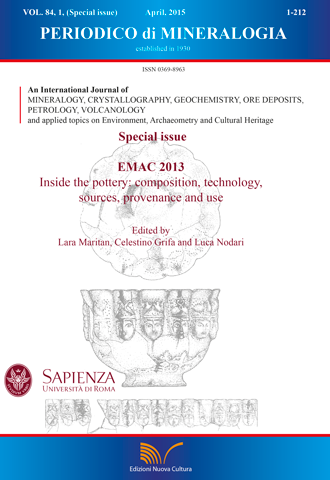Analyzing the fired-clay ceramic of EBA Canaanite pottery using FT-IR spectroscopy and LA-ICP-MS
DOI:
https://doi.org/10.2451/2015PM0011Keywords:
Canaan, Early Bronze Age, FT-IR spectroscopy, Holemouth Cooking Pots, Metakaolinite, Meta-smectite, Metallic WareAbstract
The fired-clay ceramic of EBA (Early Bronze Age) Canaanite pottery is mineralogically and chemically analyzed by using FT-IR spectroscopy and LA-ICP-MS. Spectral analysis by second-derivative and curve-fitting techniques is applied to the FT-IR spectra in order to improve the identification of the compositional phases. In the firing of ceramics at temperatures no higher than 950 °C, the initial clay of the raw material is transformed into fired-clay, which is then defined as meta-clay. The meta-clay is characterized by a pseudo-amorphous, short-range ordered structure. The clay minerals kaolinite, smectite (montmorillonite) and illite are thermally transformed into metakaolinite, meta-smectite and meta-illite, respectively. In the present study, the fired-clay ceramic is analyzed in two specific classes of EBA Canaanite pottery: Metallic Ware (a group of ceramic) and holemouth cooking pots. The FT-IR spectroscopy and LA-ICP-MS results demonstrate that the major constituent of Metallic Ware is metakaolinite with quartz, indicating that kaolinitic raw material containing quartz was utilized for their manufacture. On the other hand, the major constituent of holemouth cooking pots is meta-smectite, indicating that smectitic raw material was used. An observation of both meta-clays in parts of the ceramics indicates that raw material consisting of a mixture of kaolinite and smectite was employed. The kaolinitic raw material was utilized for the manufacture of high-quality Metallic Ware because it does not swell or shrink upon wetting and drying, and can be fired to high temperatures to form impermeable, thin-walled durable vessels. However, for the manufacture of cooking pots a raw material that is stable in cooking directly over fire was required, and for this purpose smectitic raw material was utilized.


